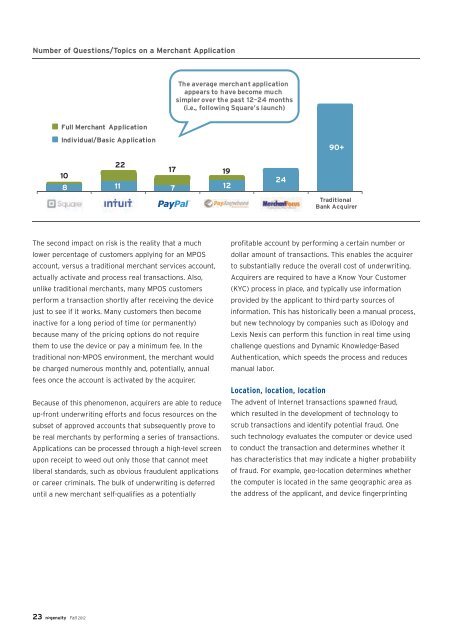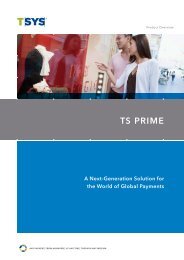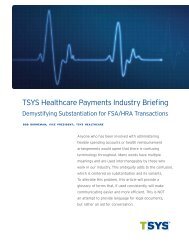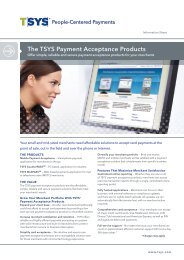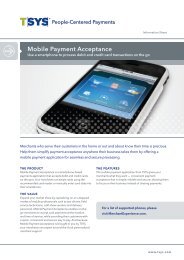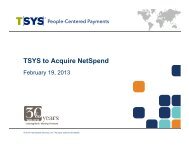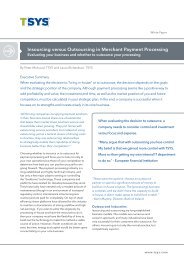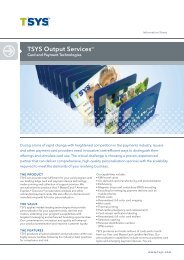The Future of Money in 2020 - TSYS
The Future of Money in 2020 - TSYS
The Future of Money in 2020 - TSYS
Create successful ePaper yourself
Turn your PDF publications into a flip-book with our unique Google optimized e-Paper software.
Number <strong>of</strong> Questions/Topics on a Merchant Application<br />
<strong>The</strong> average merchant application<br />
appears to have become much<br />
simpler over the past 12–24 months<br />
(i.e., follow<strong>in</strong>g Square’s launch)<br />
Full Merchant Application<br />
Individual/Basic Application<br />
22<br />
10<br />
17 19<br />
8 11 7 12<br />
24<br />
90+<br />
Traditional<br />
Bank Acquirer<br />
<strong>The</strong> second impact on risk is the reality that a much<br />
lower percentage <strong>of</strong> customers apply<strong>in</strong>g for an MPOS<br />
account, versus a traditional merchant services account,<br />
actually activate and process real transactions. Also,<br />
unlike traditional merchants, many MPOS customers<br />
perform a transaction shortly after receiv<strong>in</strong>g the device<br />
just to see if it works. Many customers then become<br />
<strong>in</strong>active for a long period <strong>of</strong> time (or permanently)<br />
because many <strong>of</strong> the pric<strong>in</strong>g options do not require<br />
them to use the device or pay a m<strong>in</strong>imum fee. In the<br />
traditional non-MPOS environment, the merchant would<br />
be charged numerous monthly and, potentially, annual<br />
fees once the account is activated by the acquirer.<br />
Because <strong>of</strong> this phenomenon, acquirers are able to reduce<br />
up-front underwrit<strong>in</strong>g efforts and focus resources on the<br />
subset <strong>of</strong> approved accounts that subsequently prove to<br />
be real merchants by perform<strong>in</strong>g a series <strong>of</strong> transactions.<br />
Applications can be processed through a high-level screen<br />
upon receipt to weed out only those that cannot meet<br />
liberal standards, such as obvious fraudulent applications<br />
or career crim<strong>in</strong>als. <strong>The</strong> bulk <strong>of</strong> underwrit<strong>in</strong>g is deferred<br />
until a new merchant self-qualifies as a potentially<br />
pr<strong>of</strong>itable account by perform<strong>in</strong>g a certa<strong>in</strong> number or<br />
dollar amount <strong>of</strong> transactions. This enables the acquirer<br />
to substantially reduce the overall cost <strong>of</strong> underwrit<strong>in</strong>g.<br />
Acquirers are required to have a Know Your Customer<br />
(KYC) process <strong>in</strong> place, and typically use <strong>in</strong>formation<br />
provided by the applicant to third-party sources <strong>of</strong><br />
<strong>in</strong>formation. This has historically been a manual process,<br />
but new technology by companies such as IDology and<br />
Lexis Nexis can perform this function <strong>in</strong> real time us<strong>in</strong>g<br />
challenge questions and Dynamic Knowledge-Based<br />
Authentication, which speeds the process and reduces<br />
manual labor.<br />
Location, location, location<br />
<strong>The</strong> advent <strong>of</strong> Internet transactions spawned fraud,<br />
which resulted <strong>in</strong> the development <strong>of</strong> technology to<br />
scrub transactions and identify potential fraud. One<br />
such technology evaluates the computer or device used<br />
to conduct the transaction and determ<strong>in</strong>es whether it<br />
has characteristics that may <strong>in</strong>dicate a higher probability<br />
<strong>of</strong> fraud. For example, geo-location determ<strong>in</strong>es whether<br />
the computer is located <strong>in</strong> the same geographic area as<br />
the address <strong>of</strong> the applicant, and device f<strong>in</strong>gerpr<strong>in</strong>t<strong>in</strong>g<br />
23 n>genuity Fall 2012


